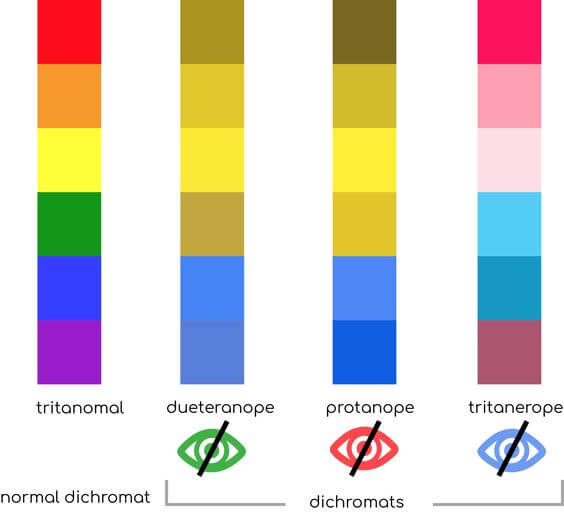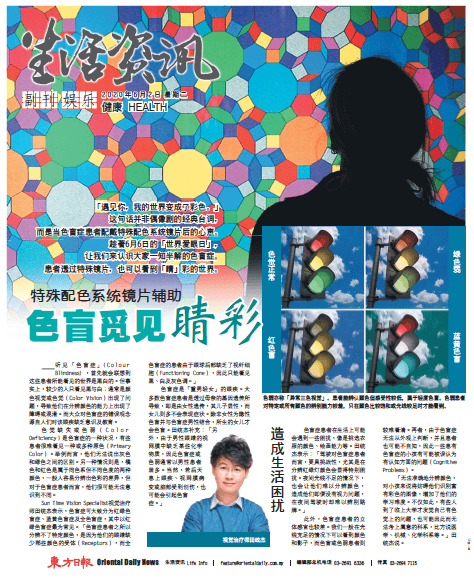Services
COLOR BLINDNESS
WHAT IS COLOR BLINDNESS?
When people encounter the term color blindness, there’s often a misconception that it means individuals with this condition see the world exclusively in black and white. In reality, those with color deficiency experience difficulties with their color vision, which can manifest as an inability to distinguish between certain colors or a general confusion when identifying colors.
For instance, some individuals with color blindness struggle to differentiate between shades of gray and green. This misunderstanding stems from a lack of widespread awareness and education about color blindness. Color deficiency is a nuanced condition; it affects individuals’ ability to perceive one or more primary colors (such as red, green, or blue) and recognize them through their retinas, located at the back of the eye.
People living with color blindness may not perceive color differences that are readily apparent to those without this condition. Simultaneously, individuals with mild color deficiency may be unaware of their condition altogether.


PREVALENT FORMS OF COLOR VISION DEFICIENCY
- Red-Green Color Blind (Protanopia)
- Blue-Yellow Color Blind (Deuteranopia)
- Total Color Blind (Monochromacy)
It affects clothing choices, artistic activities, object labeling, and shape recognition in both adults and children, occasionally leading to misconceptions about cognitive abilities.
COLOR VISION EXAMINATION
We provide comprehensive color blindness tests to precisely identify the type and extent of specific color deficiencies (Buta Warna, 色弱), in addition to our standard color vision screening,
FARNSWORTH D-15 TEST
This alternative color blindness assessment effectively distinguishes between different forms of moderate red-green or blue-yellow color vision impairments.
L'ANTHONY DESATURATED TEST
L’Anthony Desaturated Test is a color vision test designed to detect mild color blindness resulting from eye diseases or ocular pathology. It is a valuable tool for early diagnosis and treatment.
ISHIHARA TEST
This highly sensitive test can detect even the slightest color vision issues. It aims to identify deficiencies in either red or green receptors but cannot pinpoint the specific receptor deficiency. Deficiencies in red and green receptors are the most prevalent causes of color blindness.
CITY UNIVERSITY COLOUR VISION TEST
This test can determine the presence of deficiencies in red, green, and/or blue receptors by using everyday colors for comparison. Patients may not be aware of their test results.
HRR COLOUR VISION TEST
Similar to the Ishihara test, this examination is designed to identify deficiencies in blue receptors and classify the severity of color deficiency, ranging from mild to severe.
THE IMPORTANCE OF CONSULTING VISION SPECIALIST
If you observe a significant alteration in your color perception, it’s important to reach out to our vision expert. Such symptoms might indicate a potential issue, making it advisable to arrange a prompt consultation. Additionally, inform our vision specialist if you suspect difficulties in color vision.
IS THERE A CURE FOR COLOR DEFICIENCIES?
While there is no cure for color blindness, specialized color blindness lenses are available to enhance contrast and improve color perception. The Colorist System is a remarkable solution that aids individuals with color blindness.
The Colorist System can be worn as either contact lenses or eyeglasses, offering color blind individuals an opportunity to experience a broader spectrum of colors in their lives. These systems may include options like Chromagen lenses, ColorMAX, Colorlite, Colorview, and more.
IS IT POSSIBLE FOR A DISEASE TO INDUCE COLOR BLIND?
Color blindness is primarily linked to rare inherited diseases, many of which affect the eyes. These conditions include:
- Cone Dystrophy
- Cone-rod Dystrophy
- Achromatopsia
- Blue Cone Monochromatism
- Retinitis Pigmentosa
- Macular Degeneration
- Retinoblastoma
- Leber’s Congenital Amaurosis
These conditions can result in color vision deficiencies, although they are relatively uncommon.
CAN INDIVIDUALS WITH COLOR BLIND DRIVE?
Driving poses challenges for individuals with color blindness, particularly when discerning between traffic lights like stop and go signals.
Fortunately, the Colorist System offers specially designed glasses that assist with daytime driving. However, nighttime driving remains problematic due to reduced light, making it challenging to distinguish colors.
CAN INDIVIDUALS WITH COLOR BLIND HOLDS REGULAR JOB?
Yes, you can work in desk-based roles like administration, executive positions, or even as a manager. However, it’s important to note that the standards may vary from one country to another. In some cases, certain departments may require you to pass a specific color test, even if you failed the standard color vision test mentioned earlier.

